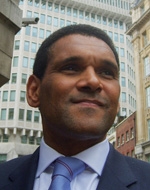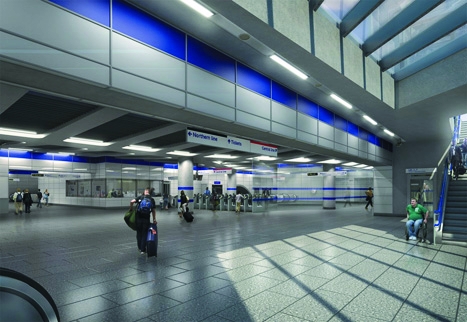As the director for capital programmes at London Underground (LU), David Waboso is the teacher-turned-engineer who oversees the delivery of everything contained within the network provider’s investment plan, which includes trains, track, signals, stations, power supplies, control systems and all other related works. He handles £1bn of capital investment and a workforce of 2,500 engineers and project managers, in addition to a further 15,000-20,000 people in the supply chain.

In his wood-panelled office, where countless fellowships hang proudly in rectangular frames, the Imperial College civil-engineering graduate explained that rising passenger numbers and a deeptube network are the two biggest factors he is constantly battling with.
The Tube transports more than a billion passengers a year – which is equivalent to the entire population of India. It is one of the busiest metros in the world and, despite a creaking Victorian infrastructure, it is doing its best to meet the expectations of Londoners and tourists alike through its Upgrade Plan.
’We are expecting a 20 per cent increase in passenger numbers by the end of the decade, which will take us up to five million passengers a day. This is due to the growth of London and the growth of suburbia,’ said Waboso, who tries to dedicate a quarter of his time to being out on site, often riding in the cab with the drivers to hear their views on new trains, stations and signalling systems.
The Tube network is primarily made up of six deep tube lines (Bakerloo, Northern, Victoria, Piccadilly, Central and Waterloo and City) and four sub-surface cut-and-cover lines (District, Circle, Metropolitan and Hammersmith and City).
Many stations have both deep tube lines and sub-surface lines passing through them and, as connections have improved, so too has the number of passengers going through the ticket barriers.
“A lot of our stations are at or beyond capacity. If we increase the number of passengers, we have to make sure we can get them in and out of the stations”
’A lot of our stations are at or beyond capacity. If we increase the number of passengers in the deep tube sections we have to make sure we can get them in and out of the stations,’ said Waboso.
To meet the demands of rising passenger numbers, there are several colossal projects taking place across the network. These include nine major station regeneration projects at what Waboso described as some of the biggest interchange stations. They include (from west to east): Paddington, Victoria, Bond Street, Tottenham Court Road, Kings Cross, Farringdon, Blackfriars, Cannon Street and Whitechapel.

’We use computer-generated models to design new stations, which allows us to alter variables such as the number of passengers,’ said Waboso. The models are based on hydraulic engineering as passenger flow is similar to the flow of water. ’It likes a continuous, slow, steady movement and hates a sharp bend or a sudden narrowing,’ he said.
In addition to upgrading stations, LU is also upgrading its train stock. ’We are currently procuring 191 trains for the sub-surface railways,’ said Waboso. ’The order was the largest train order in the world and there will be 1,400 cars making their way onto the network between now and 2016.’ This means that 20 per cent of the total trains on the network will be replaced in the next few years.
A total of 18 of the air-conditioned carriages are already operating on the Metropolitan line, and by the end of next year there will be 58, claims Waboso.
It’s possible to use air conditioning on the sub-surface trains because the hot air can be let out when the train stops at stations above ground.
However, implementing air-conditioned carriages on the deep-surface lines, which can see platform temperatures rise above 30°C, is a different matter as there is nowhere for the hot air to go.
Furthermore, the narrow tunnels mean the trains are significantly smaller than those on the sub-surface lines. ’If you want to put kit on these you have to start losing passenger areas, which are already crowded,’ said Waboso, who explained that air-conditioning technology isn’t even available at the moment for the deep tube trains.
One of the big questions everyone is asking at the moment though is not ’what will the trains be like?’, but ’who will be driving them?’
A document leaked to the Evening Standard suggested that many of the 3,500 Tube drivers could be made redundant in the coming years. It claimed that automated trains – such as the ones used across the Channel in Paris and on the East London Docklands Light Railway (DLR) – could be trialled on the Underground as early as 2015 and operating by 2018.
However, Waboso revealed that none of the trains being procured for the sub-surface lines between now and 2016 will be automated. He also said that the next generation of trains, which will be for the Bakerloo, Central and Piccadilly lines, have not been designed yet, so it’s impossible to say if they will be driverless or not.
’It would be strange to say that those trains will definitely still have a cab,’ said Waboso. ’So we’re starting the discussions with our staff early, as we should do.’
He explained that the advantages, like in any automation, are that you take out human reaction time, giving the example of a driver walking to the other end of the train in a turnback situation that occurs at the end of the line. In addition, passengers will no longer hear the words: ’We are looking for another driver as the one intended for this train is not here.’
“The Olympics is going to be a big challenge and our biggest moment. We will definitely shine”
The Tube will be pushed to the limit in July and August when the Olympics arrive in London and passenger numbers rise by what is predicted to be 20 per cent. Waboso said: ’Roughly 70 per cent of the additional passengers will go through Stratford.’
’There will be extra support and extra station staff. It’s going to be a big challenge and our biggest moment. We will definitely shine,’ he said, drawing on the recent successes the Tube saw during the royal wedding and the build-up to Christmas.
Q&A Train of thought
What is your favourite station and why?
North Greenwich is my favourite station because I was on the original Jubilee line extension. I remember years ago listening to the song ’Kind of Blue’ by Miles Davis at 3am on the morning before the station opened for the first time and thinking that it was the most surreal experience I had ever had. Upton Park is another one of my favourite Tube stations because I am a West Ham supporter.
Which station would you show to a tourist?
Canary Wharf or Westminster because they’re amazing cathedral-like places. I think Tottenham Court Road is going to be absolutely incredible when it opens in 2016. We’re starting to get that Jubilee line feel of those big new stations across the rest of the network.
What is your favourite underground network outside London?
Hong Kong’s MTR. It’s so reliable, so modern and so efficiently run. I’m a big fan of a tube transforming a place and that’s what the MTR has done. It’s very similar to London in that the metro is the lifeblood of the city.
Can we expect to see 24-hour service on the Tube?
Not in the short term. The places where it is run simply have more tracks than us. New York is the obvious example and they have four tracks – an inner set and an outer set. This means they can run one set and maintain the other, or vice versa. London only has two tracks.
What is your attitude towards new technology?
We can’t sit here and pretend technology isn’t changing; we need to exploit it. We are looking at introducing Wi-Fi in up to 120 of the 270 stations. We did a trial, which was quite successful, and we’re hoping to have Wi-Fi for passengers by the Olympics. Passengers could also be waving their credit cards in place of their Oyster cards in the future.
Education
MSc/DIC in Civil Engineering from the Royal Academy of Engineering
Career
1996 Awarded first prize as UK Project Manager of the Year for his work on the DLR’s moving block re-signalling
Late 1990s Successfully led the integration and commissioning of different contractors’ systems in time for the millennium opening of the Jubilee line extension
2000-05 Appointed systemsdirector for the Thameslink project;
programme director for the European Rail Traffic Management System; and
executive director, technical, at the Strategic Rail Authority
2005 Appointed London Underground’s director of engineering
2007 Selected as president of CoMet (the international organisation of metros), working with metro rail organisations to benchmark best practice
2011 Presented with fellowship to City and Guilds




Nanogenerator consumes CO2 to generate electricity
Whoopee, they've solved how to keep a light on but not a lot else.